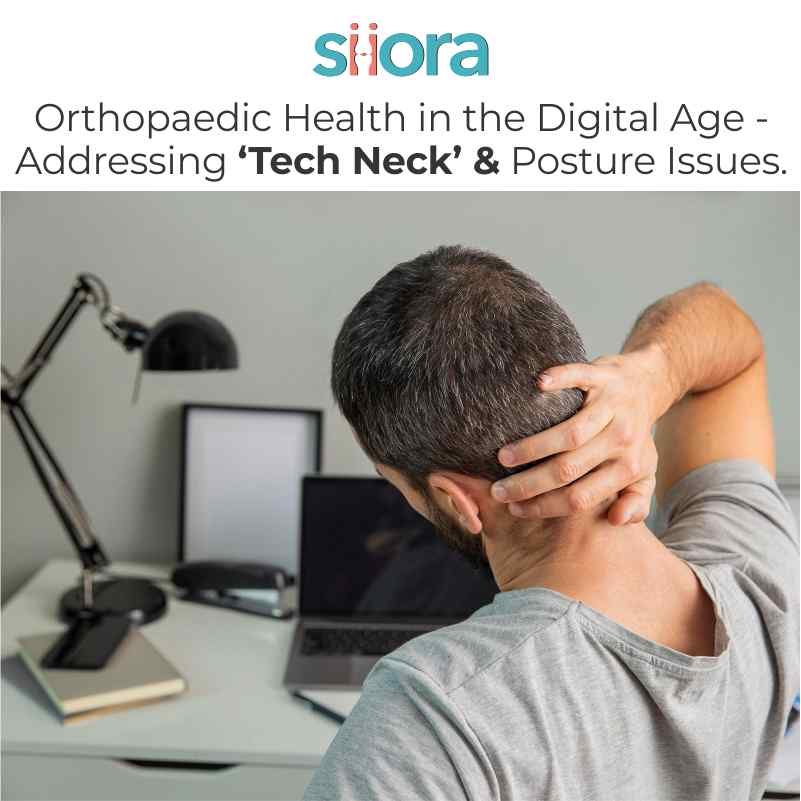We are living in a digital age, and technology is playing a key role in all our lives. From smartphones to laptops, we are constantly connected and engaged with screens. While technology has brought about many conveniences and benefits, it has also given rise to a new set of health issues. One of the most prevalent problems is “tech neck” and poor posture. In this blog, we will explore the impact of technology on our orthopedic health and discuss ways to address these issues.
Understanding Tech Neck and Poor Posture
“Tech neck” is a term used to describe the strain and discomfort that can result from constantly looking down at screens. Whether you’re texting, browsing social media, or reading emails, the habit of tilting your head forward to view your device can have significant consequences for your neck and spine.
When you bend your head forward to look at a screen, you increase the weight and pressure on your neck and upper spine. According to a study, for every inch your head tilts forward, it adds an extra 10 pounds of pressure on your neck. This means that if you’re looking at your phone with a 60-degree tilt, it’s equivalent to putting 60 pounds of weight on your neck – a considerable strain.
In addition to tech neck, the digital age has also contributed to poor overall posture. Many individuals spend hours sitting at their desks, hunched over their computers, and this can lead to a host of orthopedic issues, including back pain, spinal misalignment, and muscle imbalances.
The Impact of Tech Neck and Poor Posture on Orthopedic Health
The consequences of tech neck and poor posture on orthopedic health are far-reaching. Here are some of the most common issues associated with these problems:
Neck Pain
The constant strain on the neck can result in chronic neck pain. Over time, this can lead to muscle stiffness and discomfort.
Back Pain
Poor posture can contribute to back pain, especially in the lower back. When you slouch or sit with an incorrect posture, it places added stress on the lumbar spine.
Spinal Misalignment
Prolonged poor posture can lead to spinal misalignment, which can affect the curvature of the spine and lead to more severe issues down the line.
Muscle Imbalances
Muscle imbalances can occur when certain muscle groups are overused while others are underutilized. This can result in pain and dysfunction in various parts of the body.
Decreased Lung Capacity
Slouching can compress the ribcage and limit lung capacity, making it harder to breathe deeply.
Headaches
Poor posture can strain the neck and upper back muscles, which can lead to tension headaches.
Reduced Confidence
Your posture also has an impact on your self-confidence. Good posture can make you appear taller and more confident, while poor posture can have the opposite effect.

Addressing Tech Neck and Poor Posture
Now that we understand the potential consequences of tech neck and poor posture, let’s explore some strategies to address and prevent these issues:
Ergonomic Workspace
If you spend a significant amount of time working at a computer, it’s crucial to set up an ergonomic workspace. This includes an adjustable chair, an ergonomic keyboard and mouse, and a monitor positioned at eye level to reduce the need to tilt your head forward.
Regular Breaks
Make it a habit to take short breaks from your screens every 30 minutes. Stretching a bit and moving around can help relieve muscle tension.
Neck and Shoulder Exercises
Incorporate neck and shoulder exercises into your routine to strengthen these areas and improve their resilience. Simple stretches and resistance exercises can make a big difference.
Posture Awareness
Try maintaining the right posture throughout the day. Use reminders or apps that encourage you to maintain good posture.
Yoga and Pilates
These exercises can help improve posture and strengthen the muscles that support a healthy spine.
Chiropractic Care
Regular visits to a chiropractor can help align your spine and address any existing issues.
Physical Therapy
If you’re already experiencing pain or discomfort, consider seeking the guidance of a physical therapist who can provide tailored exercises and treatments.
Mindfulness and Breathing Techniques
Practicing mindfulness and deep breathing can help you become more aware of your posture and make conscious adjustments.
Wearable Posture Devices
There are wearable devices available that can alert you when you’re slouching, providing a gentle reminder to correct your posture.
Educate and Raise Awareness
Share information about the importance of good posture with your family, friends, and colleagues. Also, encourage them to adapt to positive changes.
Conclusion
In the digital age, tech neck and poor posture have become increasingly prevalent issues that can have a significant impact on our orthopedic health. Understanding the consequences of these problems and taking proactive steps to address and prevent them is crucial for maintaining a healthy spine and neck.
By creating ergonomic workspaces, incorporating regular breaks, performing neck and shoulder exercises, and practicing good posture, we can mitigate the negative effects of our digital habits. Chiropractic care, physical therapy, and mindfulness techniques also play a valuable role in improving orthopedic health.
Ultimately, the key to addressing tech neck and poor posture is awareness and a commitment to making positive changes. By taking these steps, we can enjoy the benefits of the digital age without sacrificing our orthopedic health.
Siora Surgicals Pvt. Ltd. is a renowned orthopedic implant manufacturer in India. The company has been serving the orthopedic fraternity for over 3 decades. In this period, it has served hundreds of global clients in over 50 countries. Siora specializes in producing hundreds of different types of orthopedic implants and instruments. Medical-grade stainless steel and titanium are being used to manufacture implants. Each implant passes through stringent quality checks before being sent to the inventory. Siora is also a trustworthy contract manufacturing/OEM service provider across the globe.








